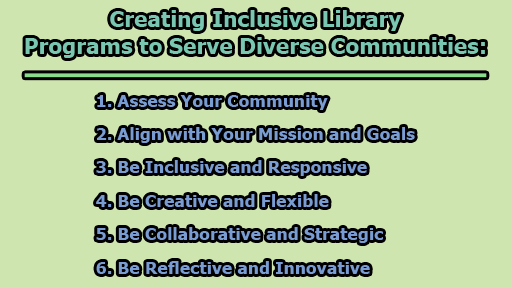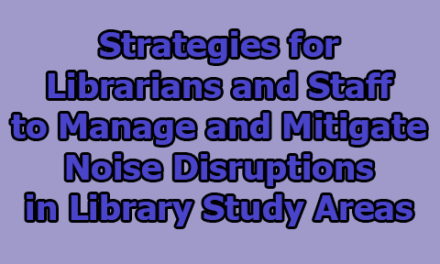Creating Inclusive Library Programs to Serve Diverse Communities:
Libraries are more than just repositories of books and information; they are vital community hubs that promote learning, creativity, and engagement. To effectively serve the diverse needs of their patrons, libraries must develop and deliver programs that reflect the unique interests, backgrounds, and requirements of their community members. In this article, we will explore creating inclusive library programs to serve diverse communities, drawing inspiration from tips and real-world examples.
1. Assess Your Community: Before designing any library program, it’s imperative to have a deep understanding of the community you serve. Utilize a variety of methods like surveys, focus groups, interviews, observations, and analytics to gather data and feedback from your patrons. Additionally, consult with local organizations, community leaders, and groups representing different segments of your community. By thoroughly assessing your community, you can identify gaps, opportunities, and challenges for your programming.
Example: The New York Public Library has been actively engaging with its community through outreach programs and surveys. These efforts have led to the development of targeted programs, such as language classes for immigrant communities, tailored to meet the specific needs and interests of its diverse patrons.
2. Align with Your Mission and Goals: Library programs should be closely aligned with the library’s mission and goals, as well as the broader strategic plan of the institution. This alignment aids in the prioritization, justification, and evaluation of programs, while also helping communicate their value to stakeholders. Tools like logic models, SMART objectives, and outcome-based evaluation can be used to plan and measure the effectiveness of your programs. Aligning with national and international standards and frameworks, such as the Sustainable Development Goals, can also enhance program relevance.
Example: The Seattle Public Library, with its mission of bringing people, information, and ideas together to enrich lives and build community, aligns its programs to promote inclusivity and community-building. Their “Bridges to the Community” program fosters partnerships with local organizations to deliver services addressing various community needs.
3. Be Inclusive and Responsive: Library programs must be inclusive and responsive, accommodating the diversity in your community, including cultural, linguistic, social, economic, and physical differences. Principles like universal design for learning, cultural competence, and equity, diversity, and inclusion should guide program development and delivery. Involving the community in the co-creation, co-delivery, and co-evaluation of programs, as well as encouraging feedback and suggestions, is key to ensuring their responsiveness.
Example: The Toronto Public Library’s Cultural Access Pass program offers free access to museums, galleries, and cultural attractions to new Canadian citizens. This program aligns with the library’s commitment to inclusivity and cultural sensitivity.
4. Be Creative and Flexible: Library programs should be creative and flexible to adapt to evolving community needs and preferences, as well as emerging trends in the library field. Methods like design thinking, brainstorming, prototyping, and piloting can be employed to generate and test new ideas. Leveraging the strengths and resources of library staff, partners, volunteers, and technology can enhance program offerings.
Example: The San Francisco Public Library’s “Library Takeout” program, initiated during the COVID-19 pandemic, allowed patrons to order books for pickup at neighborhood libraries. This creative adaptation ensured continued access to library resources in a safe and convenient manner.
5. Be Collaborative and Strategic: To maximize their impact and reach, libraries should develop collaborative and strategic programs. Partnering with other libraries, organizations, agencies, and community groups can offer complementary expertise, resources, and audiences for programs. Aligning programs with local, regional, and national initiatives and events relevant to the community can also boost visibility and sustainability.
Example: The Brooklyn Public Library’s “Culture Pass” program partners with cultural institutions in New York City to provide library cardholders with free access to various cultural venues, thereby enriching the cultural experiences of the community.
6. Be Reflective and Innovative: Ensuring program quality and effectiveness is an ongoing process. Collect and analyze data and feedback from program participants, partners, and staff using methods like surveys, interviews, focus groups, observations, and analytics. Tools like SWOT analysis, PEST analysis, and benchmarking can be used to assess strengths, weaknesses, opportunities, and threats, as well as to identify best practices and areas for improvement.
Example: The Chicago Public Library utilizes regular surveys and feedback mechanisms to gather insights from patrons, allowing them to continually refine and innovate their programs, enhancing their overall quality and relevance.
In conclusion, to create library programs that meet diverse needs, libraries must begin with a comprehensive understanding of their community’s demographics and interests, obtained through surveys and community input. Collaborating with local organizations ensures that programs are culturally sensitive and inclusive, while prioritizing accessibility makes programs open to all, regardless of abilities or backgrounds. Establishing feedback mechanisms and regularly evaluating program effectiveness using data is vital to refining offerings. Additionally, providing cultural competence training for library staff fosters an inclusive and responsive library environment. By following these principles and examples, libraries can continue to evolve and better serve the ever-changing and diverse needs of their communities.

Library Lecturer at Nurul Amin Degree College










